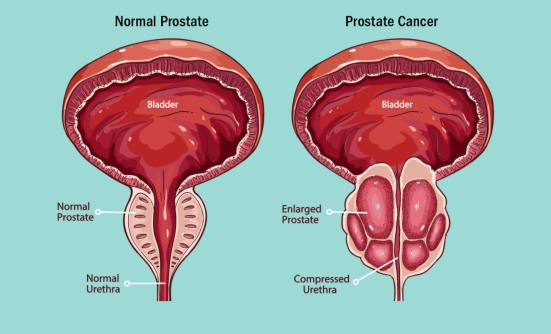The addition of a new targeted radioligand (radiation therapy), 177Lu-PSMA-617, to the standard of care in men with prostate-specific membrane antigen (PSMA)-positive metastatic prostate cancer led to a 38% reduction in the risk of death compared with the current standard of care alone, according to new findings presented at the 2021 ASCO Annual Meeting.
PSMA is a type of antigen that is expressed exclusively in prostate cancer cells, and 177Lu-PSMA-617 is a new type of radiation therapy that specifically targets that antigen to stop the progression of prostate cancer cells.
New Treatment Option

In the phase 3 VISION clinical trial, at an average follow-up of 20.9 months, the addition of 177Lu-PSMA-617 to the standard of care improved the average length of survival by 4 months compared with the standard of care alone. Adding this new targeted therapy also resulted in a 5.3-month improvement in the average length of survival without cancer progression, as confirmed by radiography (known as “radiographic progression-free survival”), which amounted to a 60% reduction in the risk of cancer progression or death.
“These findings warrant adoption of 177Lu-PSMA-617 as a new treatment option in patients with metastatic castration-resistant prostate cancer, pending FDA approval,” said Michael J. Morris, MD, Head of the Prostate Cancer Section at Memorial Sloan Kettering Cancer Center in New York City, who presented the study results.
On June 16, 2021, the FDA granted 177Lu-PSMA-617 a breakthrough therapy designation. The drug is still being reviewed by the FDA for regular approval.
“This is an important study, as the patients in this trial had metastatic castration-resistant prostate cancer, so they had disease that grew even when testosterone in the body had already been reduced to very low levels, despite receiving 1 to 2 prior taxane regimens,” said 2020-2021 ASCO President Lori J. Pierce, MD, who commented on this study.

“This trial shows an alternative to traditional therapies, by using radiation targeted to the PSMA antigen. So, it could be delivered directly to the prostate cancer cells, and by doing that, survival was significantly improved. Use of the PSMA radioligand therapy, if it obtains regulatory approval, could indeed become an important treatment option for these patients with refractory [not responding to treatment] disease,” Dr. Pierce suggested.
The VISION study used the new PSMA-directed radioligand as treatment for prostate cancer.
The VISION Study
The open-label, randomized, phase 3 VISION clinical trial included 831 patients with progressive PSMA-positive metastatic prostate cancer who received at least 1 novel androgen receptor-directed therapy, such as Xtandi (enzalutamide) or Zytiga (abiraterone acetate), and had previously received 1 to 2 taxane-based therapies.
All patients had PSMA-positive disease, and their demographics and disease characteristics were well-balanced. Previous treatment with radium-223 was not allowed.
The patients were divided into 2 groups: 551 patients received 177Lu-PSMA-617 plus standard of care and 280 patients received standard of care alone.
The standard of care was determined by the individual researchers. The main study measures were overall survival and survival without disease progression, as confirmed by radiography.
The average overall survival was 15.3 months in the 177Lu-PSMA-617 arm versus 11.3 months in the standard-of-care-alone arm, a 38% reduction in the risk of death. The radiographic progression-free survival was 8.7 with 177Lu-PSMA-617 versus 3.4 months with standard of care alone, a 40% reduction in the risk of disease progression or death.
The rate of response to therapy was 29.8% with 177Lu-PSMA-617 versus only 1.7% with the standard of care alone. The rate of disease control was 89.0% with 177Lu-PSMA-617 versus 66.7% with the standard of care. The average time to first symptomatic bone-related side effects was 11.5 months in the 177Lu-PSMA-617 group compared with 6.8 months in the control arm, all statistically significant differences.
Based on the findings of the VISION study, the manufacturer plans to file for FDA approval of 177Lu-PSMA-617 for the treatment of men with metastatic prostate cancer. This new therapy is also being studied for the treatment of men with earlier stages of prostate cancer.
PET PSMA Scan
PET PSMA scan is becoming a standard test for the diagnosis of metastatic prostate cancer, because it can detect cancer cells that are not seen on traditional diagnostic scans.
Currently, 2 PSMA PET-directed imaging agents are approved for diagnosis of patients with metastatic prostate cancer, including Ga 68 PSMA-11 and 18F-DCFPyL.
Side Effects
177Lu-PSMA-617 treatment was well-tolerated. The most common side effects of all grades in the 177Lu-PSMA-617 arm were fatigue (49.1%), bone marrow suppression (47.4%), dry mouth (39.3%), nausea or vomiting (39.3%), kidney side effects (8.7%), second primary malignancies (2.1%), and intracranial bleeding (1.3%).
Serious treatment-emergent side effects were reported in 52.7% of patients in the 177Lu-PSMA-617 arm compared with 38% of patients treated with the standard of care alone.















